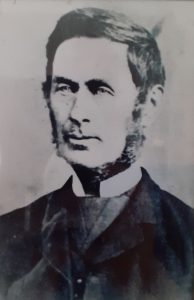
David Gorry, my great-grandfather.
In mid-August 2025 I attended a conference in Glenmalure marking the 200th anniversary of the death of Michael Dwyer, one of the leaders of the 1798 Rebellion in Wicklow. Two hundred years seems a very long time. The world has changed so much during my lifetime. In comparison, two hundred years in a vast expanse of history.
Weeks after the conference, when looking at this photograph of David Gorry, newly hanging on the wall in my sitting room, it occurred to me that Dwyer died in the same year as my great-grandfather was born. Yes, I did say my great-grandfather, not great-great-great … I come from a line of mature fathers. David was about 52 when my grandfather, Joe Gorry, was born. Joe was 32 when my father was born. My father was a month short of 50 when I was born.
Now, I have to admit that I don’t have absolute documentary proof that David Gorry was born in 1825. I’m forever preaching to beginners at family history that stated ages recorded in later life (or at death) should be regarded as approximations. And I stand by that. But I have good reason to think that 1825 was David’s year of birth.
According to his death record and his memorial card, he was 72 when he died in August 1897, making his birth year 1824 or 1825 if you’re to believe the information. Decades ago I found a baptismal record dated April 1822 that I accepted as his for a long time. That baptism was in Kilbeggan Roman Catholic parish. His parents, Patrick Gorry and Anne Burke, had an older son, Patrick, also baptised in Kilbeggan in 1820.
David had three known younger siblings, William, Matthew and Maria, whose estimated birth dates were all in the 1830s. They probably were baptised in Killeigh, as the family moved to Cappyroe in that RC parish sometime between 1826 and 1842. Unfortunately, the surviving baptismal records for Killeigh date only from 1844. The reason I say that they moved to Cappyroe after 1826 is that they were a farming family and Patrick Gorry was not listed in the Tithe Applotment for Cappyroe (in Geashill Church of Ireland [subsequently civil] parish) in that year. He had a substantial acreage in later years, albeit as a tenant from year to year.
I’ve never found a baptismal record of any child of Patrick and Anne Gorry after 1822 and it’s highly unlikely that they had NO children between that date and the 1830s. By deduction I can say that they had no children born in Kilbeggan RC parish in those years (as its baptisms are complete). Likewise, they were not living in Killeigh RC parish up to 1826, unless they were temporarily living elsewhere in that parish prior to moving to Cappyroe.
Looking at other RC parishes in the general area, those without surviving records for 1823-1828 are Castletown Geoghegan, Clara & Horseleap, Moate, and Rhode. Additionally, there is a gap in the Lemanaghan baptisms from December 1824 to February 1826, while the Tullamore baptisms have a gap from 1822 to February 1827.
My theory is that Patrick and Anne had children in that period and that one of them was a second David, born in 1824-1825, who was my great-grandfather. People familiar with Irish RC family history will know that it was common practice to reuse the forename of a child who died young. Very often, after a child died the next child born, of the same gender, was given the same name. That may sound unfeeling but it was the opposite, keeping the name and the memory of the deceased child in the family. Actually, my father had two brothers named David. The first, called ‘Dainie’, died in 1910 and the second was born five months later.
So, It’s my belief that the David Gorry who was born in 1822 died as an infant and the next boy was also named David. That second David most likely was born in 1825, or maybe late 1824, making it two hundred years since his birth. Anyway, it’s given me a reason for me to reflect on the life of this man whose existence was in an era very much removed from the one with which I’m familiar. He was a farmer in Cappyroe all his working life and a rate collector for decades: ‘for half a century’ according to his obituary in the Midland Tribune. He married in 1864, presumably aged 39. His wife was Julia Dunne. They had 10 children, two girls and eight boys. David died on 12 August 1897, of heart disease. He was buried in a family plot in Durrow, north of Tullamore. The last survivor of his children was my grandfather, who died when I was almost ten months old.
